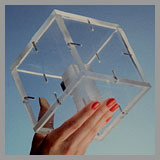 |
In 1997-98 the San Jose Museum of Art staged "Alternating Currents: American Art in the Age of Technology", the third
in a series of four exhibitions in collaboration with the Whitney Museum of American Art. "Alternating Currents surveys
a critical period in American art when a search for forms and materials relevant to an industrial and technological
age marked the efforts of many key artists and initiated a broader dialogue about what constitutes a work of art."
Among the artists included are; Lewis Baltz, Tom Otterness, Robert Rauschenberg, Robert Irwin, Nam June Paik, James Turrell,
Nancy Burson, John Baldessari, Jenny Holzer and Tony Oursler.
In addition to a compilation of masterworks from the Whitney's permanent collection, San Francisco bay area artist
Joel Slayton was invited to create a site installation work. The installation, Not to See a Thing,
involves collection and mapping of data derived from audience interaction with a virtual simulation which
represents a surveilled object.
| C5 - Theory as product C5 is the corporation of acculturation; a collaborative endeavor which devises theoretical models, analysis and tactical implementations of technology for assessment and information mapping. Project Description: To think about networks with spatial analogies is highly problematic. This C5 project suggests that the intersection of data agencies and data attributes forms a network topography. Mingling, the perturbance of an information topography by a network identity (IP address), results in the emergence of new data alliances. The 16 Sessions project applies data agencies and data attributes generated from Not to See a Thing to a proprietary Mesh database of validated http IP addresses under development at C5. The data has been reduced and Mingling algorithms have been developed so the users network identity can generate "feelers" into potential information relations. Such relations can then be collapsed into structural couplings which are both arbitrary and contextual. Mingling requires a pragmatic contemplation of its own topological limits.
16 Sessions procedures
16 Sessions commission by |